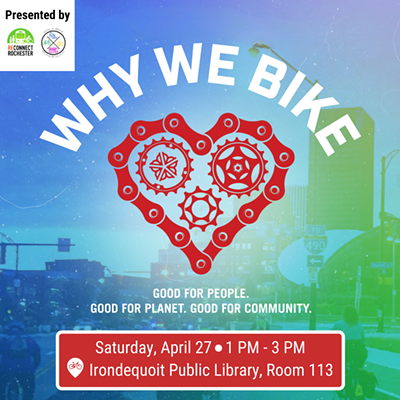ANNUAL MANUAL '12: Rochester Monuments
Permanent markers. A look at some of Rochester’s most interesting, and sometimes overlooked, monuments
By Katherine Stathis[
{
"name": "500x250 Ad",
"insertPoint": "5",
"component": "15667920",
"parentWrapperClass": "",
"requiredCountToDisplay": "1"
}
]
Rochester's history is a fascinating study, only partly told by our standing monuments. As permanent dedications, these structures are anything but motionless -- they have a tendency to move with our changing city, unlike our dedicated grand spaces, such as MountHope and Holy Sepulchre cemeteries. Just within city limits, discovering the stories behind the sites and statues is itself a treasure hunt of monumental proportions.
Perhaps most central of these Rochester landmarks is the Soldiers and Sailors Monument in Washington Square Park (N. Clinton Avenue and Woodbury Boulevard), a 42'-tall bronze and granite tribute the Civil War. Abraham Lincoln stands over four figures, each representing a military branch of the era, with bronze engravings of key Civil War events at the pedestal. The 1892 dedication by President Benjamin Harrison brought in thousands, a scene rife with bunting, flags, and fanfare. The monument has remained a nexus of social discourse ever since; the current Occupy movement is the latest in a long tradition of protesting citizens that gather around the statue.
But what is not occupying WashingtonSquarePark has observant Rochesterians perplexed: where has the Austrian Cannon gone? Only its base remains. The mysteries may be a worthy case for Sherlock Holmes, which may not be entirely inconceivable given this city's link to the fictional detective's creator, and the movement that claims to have contact with those who have died.
Indeed, modern Spiritualists have local roots. The Fox sisters -- Kate, Leah, and Maggie -- lived in the region in the 1840's, when Rochester was a boomtown and a hotbed for progressive thought and religion. The Fox sisters famously claimed the ability to hear "spirit rappings" ("Rochesterrappings," as they were known), enabling them to communicate as mediums. In 1927, through the suggestion and generous funding of Sir Arthur Conan Doyle, himself a Spiritualist, a 25' obelisk was raised to honor the sisters at the PlymouthSpiritualistChurch in Corn Hill. The church was later razed, and in 1954, the SpiritualistMonument (Troup Street, east of Plymouth) was moved, now standing at the edge of the Inner Loop.
The Inner Loop, itself a monument to 1960's urban renewal, paved a path of convenience around the city at the expense of historic neighborhoods and splendid parks. Now those locales can be excavated only through photographs and antique maps.
One such lost park was Franklin Square, a northeast downtown oasis surrounded by Victorian homes, many of which belonged to the German-Americans who played integral roles in Rochester business and commerce. In 1941, during a period of heightened patriotism, the Spanish-American War Memorial (between the CourtStreetBridge and Blue Cross Arena) was dedicated in a scene of waving American and British flags. The drama of this bronze sculpture, an Art Deco eagle "sundering the chain of oppression" atop a forward-jutting pedestal, was initially intensified by the reflecting pool beneath. Imagine this scene when viewing the eagle in its current location, where it has stood since 1960.
AndersonPark was another lost to "progress," once bordered by University Avenue, North Union Street, and Main Street, where in 1908 the Schiller Monument was dedicated to honor German poet and playwright Friedrich Schiller. The monument, a bronze bust atop a tall pedestal and platform flanked by benches, was moved in 1964 to where it stands today, in a remnant of Franklin Square renamed SchillerPark (Andrews Street, facing Liberty Pole Way). From the profile, Schiller appears to be perpetually brooding, but there may be a hint of lift to his lips if you catch his gaze from the front. At any rate, he could use some company.
His friend and contemporary, Johann Wolfgang von Goethe, also stands immortalized. The GoetheMonument (South Avenue and Reservoir) remains where it was first dedicated in 1950, amid the verdant surroundings of what is now the Highland Bowl. Commemorating the 200th anniversary of Goethe's birth, chief speaker and former head of University of Rochester's English Department John Slater encapsulated an era with poignancy: "Here, in times of intolerance and bitterness, we raise a statue to Genius."
Rochester's German-American influence endures through names as ubiquitous as Bausch and Lomb, and their community's preservation efforts can serve as inspiration today. The Henry Lomb Memorial (Upper Falls Boulevard, east of St. Paul), dedicated in 1932, was in danger of demolition in 1973 to make way for a sewer tunnel and proposed roadway. The German-American societies rallied, obtaining a court order temporarily blocking the wrecking ball, and a solution was reached. This explains why the 48' black Minnesota granite shaft now stands in the middle of the road.
The monument honoring Rochester's preeminent inventor and philanthropist, George Eastman, surprises many. The striking gray-pink Georgia granite George Eastman Memorial (Lake Avenue, just north of Ridge) entombs his ashes under the sunken plaza at KodakPark industrial complex. This 1934 monument inspires reflection upon any visitor, and is a must-see for all Rochesterians.
Perhaps the most moving monument in the city is the Greater Rochester Vietnam Veterans Memorial (South Avenue, between Highland and Elmwood). More experience than monument, the memorial brings visitors through a winding path of varied topography flanked by a timeline of the war's events on the left, and a humbling line of bollards on the right naming the 280 casualties from our six-county region. This journey and the monuments central to it are designed "to commemorate, to educate, and to heal."
Nearby, across the street from the Spanish-American War Cannon (at the South Avenue entrance to Highland Park) the FrederickDouglassMonument (South Ave, facing Highland Bowl) stands silently addressing the public, with a better view of summertime Shakespeare than Goethe's. But this was not the original site where the statue was dedicated in 1899. Governor Theodore Roosevelt led the ceremonies to honor the respected abolitionist, orator, and publisher of The North Star. Thousands thronged to what was deemed Douglass Triangle at St. Paul Street and Central Avenue. As urban traffic congestion rose, the monument was moved in 1943 to a site closer to Douglass's South Avenue home that no longer stands. This was the first publicly funded monument in the country to honor an African American, moving Booker T. Washington to remark, "This monument is grand and it is the only thing we have."
Other monuments honoring Rochester notables include the Austin Steward Memorial (Radisson Hotel, 120 E. Main St.), at the site of the general store opened in 1818 by the former slave-turned-Rochester's first black businessman; the Edward Mott Moore Memorial (East River Road entrance to Genesee Valley Park at Elmwood), dedicated in 1927 to the man who fought to create the Rochester park system; the Cab Calloway Memorial (Otto Henderberg Park in Swillburg), dedicated to Rochester's most famous hepcat; the Morrie Silver Memorial at Frontier Field; and of course, a pensive Nathaniel Rochester at South and Alexander.
A trip to the local history department in Rochester's Central Library is highly encouraged for those who wish to forage more deeply to see the whole story of what only partially remains.
Do you have a favorite local monument you would like to add to this list? Please comment on this article at rochestercitynewspaper.com.
In This Guide...
Speaking of...
-
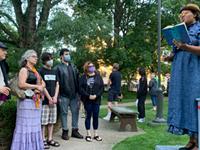
A resurrected Rochester in ‘flOUR CITY Interactive ROCgarden’
Sep 20, 2021 -

Urban Action 10/10
Oct 10, 2018 -
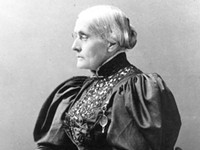
Building a 'progressive' city
Mar 21, 2018 - More »
Latest in Annual Manual
More by Katherine Stathis
-
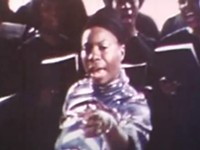
FILM | 'The Spirit of Protest in Black Culture'
Jan 21, 2021 -
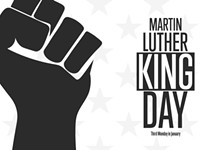
Martin Luther King Jr. Day commemorations to stream and attend
Jan 14, 2021 -

Snowshoe to beat the winter blahs
Jan 7, 2021 - More »





